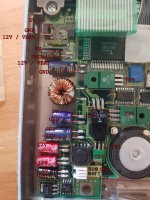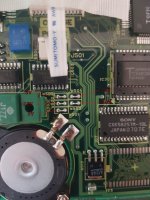http://www.minuszerodegrees.net/manuals/Toshiba/Other/Toshiba T1000LE - Maintenance Manual.pdf
Try this, starting from page 10. It doesn't have your exact issue, but it gives you things to check.
Thanks.
I already downloaded the manual earlier and read it carefully but sadly it only has high-level troubleshooting instructions. No schematics or expected voltage at various test points, for example.
I used an ESR meter and measured the ESR of all through-hole electrolytics capacitors on the mainboard and the power supply board (near the LCD). 1 of them had obviously leaked (ESR reads at least 100 Ohm with signs on the board) while two others have not yet leaked but read high ESR (1-2 Ohm). I replaced them with new capacitors having the same specs. For the rest of the capacitors, no leaking signs are found and their ESR are well within specs (0.3 - 0.5 Ohm) so I will leave them as is first.
My thoughts as to why the computer turns itself off after showing the error message (the manual says I can press any key to reset the configuration or F1 to enter BIOS, but I can't because it turns off immediately):
1. A short somewhere on the mainboard making the power supply shut down due to a short circuit. When manually supplying 7.2V through the battery contacts, my bench power supply registers as high as 1.89A when the computer is powered on before it is automatically shutdown, but this does not seem to be too large a current.
2. Something (e.g. faulty components) causes the power supply to think that the battery is dead (low voltage) and shutdown to prevent damage. After replacing the capacitors, I also tested the diodes but they seemed to be fine though. Other SMD components and several ICs are too difficult to test without a schematics.
3. It may be a software issue - the motherboard powers off since it can't read the configuration. For this I made a mistake of removing the rechargeable RTC battery to make it easier for disassembling, which was not necessary and might have caused the configuration to be lost. However, this seems unlikely to be an issue as the manual says the configuration can easily be reset.
My prognosis is that since the error message showed up upon booting on the screen with a beep in the PC speaker and the floppy drive seek sound, most of the board components are more than likely to be fine.
Any further thoughts? I will try to take some photos tonight.


